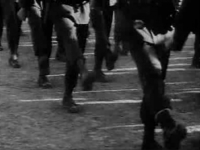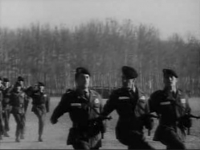The US Military in Iran: Before, During, After the Coup
This archival film made by the US Army in late 1950s or early 1960s promotes the role of MAAG personnel in Iran.
The Big Picture: Assignment Iran
The US Military had been active in Iran and involved in various bilateral projects of reconstructing the Iranian Army (ARMISH) and Gendarmerie (GENMISH) since 1941. GENMISH was led by General Norman Schwartzkopf (the father of the Desert Storm leader) until in mid-1940s the Shah appointed an Iranian General, Sadegh Kupal, to lead the gendarmerie.
Since its formation, MAAG, Military Advisory and Assistance Group, was present in Iran starting in 1950. Wilber’s report is quite explicit about the participation of US military personnel stationed in Iran in preparations for the coup by providing information and particularly in recruiting US-friendly officers in the coup operations. Schwartzkopf who had a history of friendship with the Shah was a key US emissary in the weeks immediately before the coup. His mission was to encourage the Shah to sign orders that would acknowledge Zahedi as the new prime minister and encourage the Army to support him.
Following the coup, Schwartzkopf personally trained the first generation of Iranians who formed the infamous SAVAK. US military missions, ARMISH and MAAG were consolidated and arms sales to Iran increased. In 1962, the Shah’s government granted the US military personnel in Iran extraterritorial legal status, meaning that they had legal immunity in Iran. The US sales of military equipment to Iran rapidly increased to the point that Iran became the biggest international buyer.
Quadrupling of arms sales agreement came in the wake of President Richard Nixon’s visit to Tehran in 1972. During that visit the President and the Assistant to the President, Henry Kissinger, committed the U.S. to a general guideline leaving decisions on the acquisition of military equipment primarily to the Government of Iran…. The carte blanche on arms sales was explained and supported by Joseph J. Sisco before the Special Subcommittee on Investigations of the House Committee on International Relations on June 10, 1975…. Consequently, Iran became the largest arms importer in the world. Of $8.3 billion in revenues from foreign military sales which the United States received during the fiscal year of 1974, $3 billion were placed by Iran. [Sheikh-ol-Islami, M. J. “ARMY v. Pahlavi Period.” Encyclopedia Iranica Online. Retrieved 15/12/2012]
From 1953 to 1979, MAAG became involved in every branch of Iran’s military and police forces and affected nearly every facet of Iran’s economy…. The importance of MAAG rested on its function of providing technical advice on new arms purchases, new training projects and related equipment maintenance programs as prescribed by expanding US military and economic assistance…. MAAG’s tasks were tied to a new form of military aid, that is, to the military ‘grant’ based on Iran’s natural resources primarily oil…. MAAG was from the outset a part of a long-term military sales program involving training and maintenance of increasingly sophisticated weaponry in defense of NATO interests as well as those of the United States and Iran. The military assistance program which MAAG administered, moreover, was possible only in exchange for Iran’s raw materials and semi-processed goods. [Ricks, T. “U.s. Military Missions to Iran, 1943-1978: The Political Economy of Military Assistance.” Iranian Studies, Vol. 12, No. 3/4 (Summer – Autumn, 1979)]


Leave a Reply